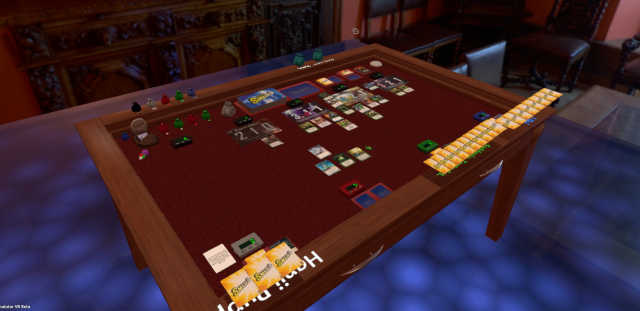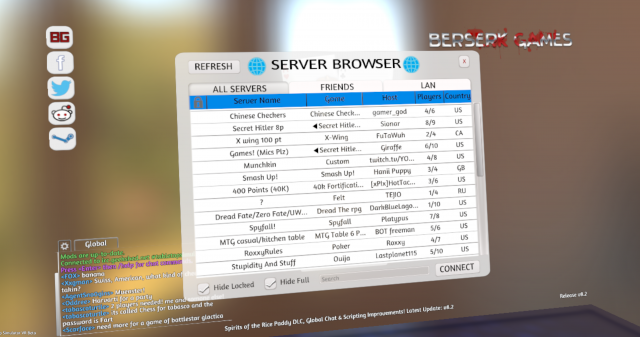After tinkering around with the social app AltspaceVR, as well as spending some time in the dedicated Ascension VR app, it was time to wade into the deep end of VR board gaming: Tabletop Simulator. While fellow contributor Nicole recently ran through the multitude of online board gaming options , Tabletop Simulator is the only established board gaming platform that offers virtual reality support. This makes Tabletop Simulator the final destination for board gamers seeking an immersive online play experience, albeit one that is still rough around the edges.
Tabletop Simulator is a universal gaming platform meant for live, human-run games, which debuted on PC in mid-2015. Users are presented a 3D representation of a game table with all of the components laid out before them, and the ability to pick up and move pieces at will. There’s no AI to play against and no  computer to move the game along, enforce the rules, or manage the bookkeeping. Strap in for the internet’s artisanal tabletop experience; this is one that involves moving your own pieces and actually communicating with the other players at your table.
computer to move the game along, enforce the rules, or manage the bookkeeping. Strap in for the internet’s artisanal tabletop experience; this is one that involves moving your own pieces and actually communicating with the other players at your table.
Out of the box, Tabletop Simulator supports a variety of generic table games such as poker and backgammon, but for a few bucks a pop, you can acquire DLC component packs for 20+ popular titles. More dedicated gamers can roll up their sleeves and put in the hours required to model whatever game they’d like, as evidenced by the several lobbies of Terraforming Mars players I spotted just weeks after the physical game’s release. All of these games support Tabletop Simulator’s VR mode, as that feature is treated as an alternate control scheme vice the keyboard and mouse.
Tabletop Simulator’s VR is advertised as a beta implementation, which serves to temper expectations. But in truth, the lack of polish is in the same ballpark as many other online board game platforms. Learning how to work around Tabletop Simulator’s occasional rough edges in VR is no more of a challenge than developing proficiency with an obtuse user interface in a traditional computing environment. Much like getting a game going in the Vassal engine, you’ll find it rewarding if you stick with it, but you’ll probably need a nap and/or a stiff drink afterwards.
Most of the sticking points with VR are tied to breaks in convention with other successful VR experiences. Immersion is a word that gets thrown around quite a bit, but it’s with due cause: the intent of a VR experience is for the controls to fade away, and it’s an unparalleled experience when achieved. Tabletop Simulator strays from the pack in a few key areas, such as how to point at menus or travel beyond short distances. For instance, using a VR controller to select menu items involves a laser-point projection from your controller’s tip, which acts as a cursor. Playing on an HTC Vive, Tabletop Simulator’s laser point projects at a drastically different angle than the Vive’s system menus, so flipping back and forth between the two can be jarring. And nobody wants to fumble around with a controller asking themselves “how do I walk to the other end of the table again?” as they ponder the different methods for movement used in other popular games.
These are all things that can be expected to improve over time, and to the developer’s credit, they’ve gone further than most to ensure a proper-scale experience for any player. Tabletop Simulator allows for fine-tuned adjustment of player height and environment scale, so you can size the table and components exactly to your liking. There’s also the handy option to point and click on any component, even from across the table, and have a full 3D model pop up right in front of your face (useful reading text on a card). The only downside here is that some components aren’t fully 3D modeled, and simply disappear if you spin them around with your hand (such as trying to look at a card’s back). You can also adjust the scale of these zoomed-in components on the fly, which is handy, as some of the default sizes are rather ill  advised (see: the time I nearly let out an audible yelp when a chess rook the size of a bear popped up inches from my face). But again, that’s an easy area to improve, and one that at the moment, shouldn’t actually affect gameplay.
advised (see: the time I nearly let out an audible yelp when a chess rook the size of a bear popped up inches from my face). But again, that’s an easy area to improve, and one that at the moment, shouldn’t actually affect gameplay.
During my time hopping around the open lobbies, I never did encounter another player using VR, but this community blog post from developer Berserk Games provides a series of great visuals:
http://i.imgur.com/fJ0N6CW.gif
This is definitely a step up from seeing other players only as tiny hand-shaped mouse cursors. But just take a look at what Oculus is developing for Facebook’s social VR app where users have representative avatars capable of capturing a wide array of emotions and interactions. If these sorts of features were rolled into a board gaming platform such as Tabletop Simulator, online board gaming could be a world class experience.
Enough about the finer points of VR, though. You want to hear about actually playing board games! Yes, you can pick up pieces and move them around with your hands. It works and it does feel awesome. Yes, you can also get angry and throw the pieces at other players (they regenerate back on the table, but there is an ever-present and ever-tempting “flip the table” button that you should allow yourself a few minutes to play around with in a solo session). The only bit that’s not 100% accurate to the table experience is a shaded box fat each player’s table edge that represents their hand. Any components placed in that area are grayed out, which serves an obvious purpose for private information, and works quite well. Overall, the experience honestly feels quite good, and if I had the right group who wanted to meet up and play a game online, I’d go for it.
Which brings us to the final aspect of Tabletop Simulator worth discussing: the clientele. You truly only want to play this game if you are bringing your own group. While there were a wide variety of tables in play, a rough scan tells me that 95+% of them are locked private groups. A dip into the public table pool quickly taught me that this was with good reason. Most of the public groups were for Tabletop Simulator’s built-in basic games and were carnivals of profanity. Entering a card game table titled “boobies” and being greeted by a man who refered to everyone as “squire” was an experience akin to entering my local 1990’s game store, i.e. not one I was ever prepared to have again. The one true modern game I managed to get in on was a table of Smash Up, which was a perfectly mature and respectable group, but filled with some of the most painfully slow gameplay I’ve ever experienced at a table, virtual or not.
I wouldn’t advocate Tabletop Simulator as cause for anyone invest in the $1,500 computer/headset combo required for proper VR, but it certainly is a nice perk. VR board gaming will never replace the traditional table and physical bits, much like TV didn’t kill off radio and film, and ebooks haven’t wholly replaced physical texts. But for the right circumstances, where getting the gang together isn’t an option and the board game itch strikes, Tabletop Simulator and VR could eventually develop into the cadillac of online board game experiences. Meanwhile, I’ll be eagerly awaiting Bit Punching Simulator.
I don’t agree. Look at http://berserkgames.tumblr.com/page/4
Sincerely, Cleopatra